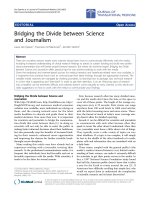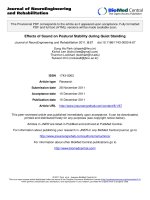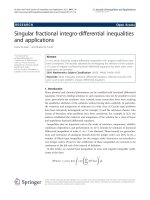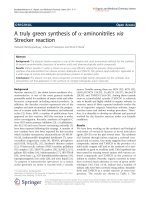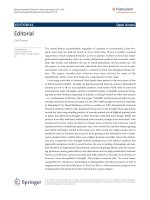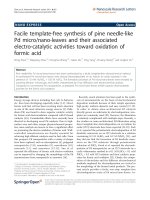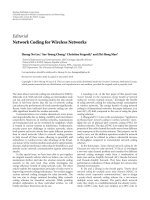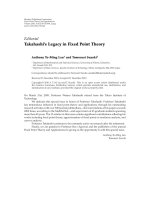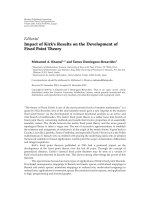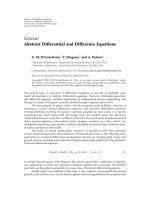Báo cáo hóa học: " Editorial Environmental Sound Synthesis, Processing, and Retrieval" pot
Bạn đang xem bản rút gọn của tài liệu. Xem và tải ngay bản đầy đủ của tài liệu tại đây (445.8 KB, 3 trang )
Hindawi Publishing Corporation
EURASIP Journal on Audio, Speech, and Music Processing
Volume 2010, Article ID 178164, 3 pages
doi:10.1155/2010/178164
Editorial
Environmental Sound Synthesis, Processing, and Retrieval
Andrea Valle
CIRMA, Universit`a di Torino, via Sant’Ottavio, 20, 10124 Torino, Italy
Correspondence should be addressed to Andrea Valle,
Received 31 December 2010; Accepted 31 December 2010
Copyright © 2010 Andrea Valle. This is an open access article distributed under the Creative Commons Attribution License,
which permits unrestricted use, distribution, and r eproduction in any medium, provided the original work is properly cited.
This special issue of the EURASIP Journal on Audio,
Speech and Music Processing is dedicated to Environmental
Sound Synthesis, Processing, and Retrieval. It aims at target-
ing the multifaceted area of research devoted to the complex
relation between environment and sound, a relation that still
needs to be investigated. Indeed, we are literally immersed
into sound: as Handel says, “Listening puts me in the world”
([1], xi). In this sense, a phenomenology of listening, delving
deeply into the philosophical and psychological aspects of
sound perception is mandatory in order to clearly under-
stand the specific features of “auditory events” with respect
to other perceptual modalities. With a classic example,
while vision is in some sense always external to our body
(emphasizing the separation between subject and object in
perception), sound on the contrary resonates through our
body, literally embodying the information that it carries on
as we vibrate through the world we are surrounded/placed
into. That is, “Listening is centripetal; it pulls you into the
world. Looking is centrifugal, it separates you from the
world” ([1], xi). Even if embracing a technologically oriented
perspective, these philosophical and psychological aspects
are not to be omitted while researching on environmental
sounds. Through a historical tendency which origins date
back to 20 years ago, sound is becoming more and more
relevant in our media environment. As an example, one can
think about sound systems in cinema, now a standard and
pervasive solution on the market. Another example is new
complex, multimodal, integrated displays now pervasively
built into portable devices. Not by chance, the first edition
of ICAD, the International Conference on Auditory Displays
dates back to 1992, and from 2000 it is held on an annual
basis. But, in order to effectively exploit sound, we have
to avoid the risk to simply borrow principles and models
from vision and to adapt them to listening, without a real
understanding of specific perceptual features of the audible
domain. Indeed, this applies to sound in general, but is
particularly relevant for sound materials that have not been
extensively studied by cultural practices with a long tradition,
as it typically happens with music and speech.
So, what is environmental sound? In some sense, sound
is necessarily environmental as it is strictly coupled with
its physical medium (including the listener). I have already
anticipated a definition ex negativo that better specifies our
field of interest: environmental sound is neither music nor
language. Indeed, such a definition is at the same time too
strict and too broad, as it supposes that there are three
distinct realms of sound, while theoretical researches and
productive practices have shown that these three aspects
of sound perception/production are deeply intermingled. It
can be noted that such a definition has been historically at
the basis of sound at cinema, where “music”, “voice”, and
“sound” have always been treated in specific ways [2, 3],
and thus it i s, in some sense, “classic”, as i t simply estab-
lishes that “sound” (here intended as the fictional acoustic
environmental scene) has a residual nature with respect to
speech and music. Indeed, in contemporary cinema too this
categorization is becoming more and more u nsatisfactory
as sound is receiving an increasing attention. That is, the
internal complexity of this third category—“sound”—is
increasingly emerging in cinema studies and practices thanks
to technological developments. This is not an accidental
aspect: from the 19th century going on through 20th (and
21th century), technolog y is continuously stimulating the
research on audio, radically challenging different contexts of
perception and production [4, 5].
In order to d eal with this complexity, it is possible to
cite at least some fields and authors that have provided
a general frame for the understanding of (environmental)
2 EURASIP Journal on Audio, Speech, and Music Processing
sound. First of all, the notion of “sound object” has been
proposed by Schaeffer [6] with the specific goal to describe
all possible sounds. Even if problematic in many respects
[7], Schaeffer’s “morphotypology” is still unsurpassed, as
it is the only theoretical framework trying to be at the
same time analytical and exhaustive. It could be noted that
Schaeffer’s perspective is deeply technologically rooted, as
the French author started his journey into sounds thanks to
the possibility, provided by recording, of listening again and
again to the same sound. More, the theoretical framework
by Schaeffer was originally aimed at providing a conceptual
tool for the organization of sound objects in music com-
position, thus linking listening practice to sound manip-
ulation. Partly moving from Schaeffer,R.MurraySchafer
firstly introduced (or, at least, theoretically discussed) the
term “soundscape” in his famous book The Tuning of the
World [8]. Now an ubiquitous term, soundscape at least
covers three different domains and relative applications
(eco/anthropology, music/sound d esign, architecture/urban
planning, [9]). Again, the interest in soundscape emerges
from the technological possibility of field recording and
of accurate, iterated, analysis of the obtained soundscape
through editing and playback. Soundscape studies, in the
context of acoustic ecology [10], hav e shown the complexity,
variety, and internal articulation of acoustic environments
coming from all the world, showing many aspects that
were completely neglected before. From Murray Schafer, the
diffusion of the term has continuously increased, and the
relevance of soundscape in the actual “mediascape ” cannot
be disputed, as c urrently the concept of soundscape plays
a pivotal role at the crossing of many sound-related fields,
ranging from multimedia [11] to psychoacoustics [12], from
working environment studies [13] to urban planning [14],
from game design [15, 16] to virtual reality [17], from
data sonification [18] to u biquitous computing [19, 20]:
soundscape is a fundamental notion for acoustic design
[21, 22], electroacoustic composition [23], and auditory
display studies [24]. The integration of soundscape in a
landscape documentation/simulation is crucial in order to
ensure a b elievable experience in human-computer inter-
action [25]. Moving on in this fast run through relevant
approaches to environmental sound, “everyday listening”
has been proposed by Gaver [26] as a specific modality
of listening to sound, mainly based on a re-construction
of some features of the sound sources. As well said by
Gygi et al. in this volume: “Although what Gaver termed
“everyday listening” is a fr equent activity, the nature of the
experience has been remarkably underscrutinized, both in
common discourse and in the scientific literature”. Listening
to every day sound also requires specific perceptual strategies,
that cannot be described in the usual theoretical framework
of psychoacoustics: in this sense, Bregman’s summa [27]
has established the notion o f “Auditory Scene Analysis”
(ASA) as a pivotal psychological basis for the perception
of complex sound mixtures like the ones we experience in
“natural” environments ( even if highly anthropized, e.g., a
city). Finally, the Sounding Object project has pioneered
the study and the application of an ecological approach
to sound and perception to the design and production of
interactive auditory displays based on physical models of
audio production/perception [25].
Following the threads I have tried to individuate in the
previous paragraphs, in this issue we have selected seven
contributions that indeed demonstrate the multifaceted
nature of environmental sound studies. Quite approxima-
tively, they can be grouped into three areas. The first subset
includes the papers by M. Takada et al. and L. Wang et al.
Takada and colleagues propose a research on the relation
between onomatopoeia and sound. Indeed, the use of voice
to reproduce sounds allows to study the way sounds are
perceived, represented and reproduced by the subjects. It
might be assumed that these features are particularly relevant
for example, in auditory display applications as they can
be embodied directly by the user and easily shared among
other users (as they can be easily reproduced through the
voice). From a strict signal processing perspective rather than
from a psychological/semiotic one, the work by Wang and
colleagues discusses a method for improving source separa-
tion in reverberant environments. Indeed, the contribution
deals with a typical and crucial problem of the auditory
domain, the fact that, to speak with a visual metaphor,
“sound is transparent” ([27], 619). In this sense, it can
be seen as a contribution to Computational ASA (CASA,
[28]), a field that aims at computationally implementing
Bregman’s approach for automated perceptual analysis of
acoustic environments. The paper by B. Gygi and V. Shafiro
discusses the creation of a large database of environmental
sounds. Mainly aimed at providing researchers a tool for
the investigation of ecologically based sounds, it shares with
the following two papers (with which it can be grouped)
the interest into large collections of sounds, indeed a major
topic in actual research, as social networking increasingly
allows users to provide and share audio contents. The
database proposed by B. Gygi and V. Shafiro still implements
a topdown perspective, as categories related to ecological
features of sounds necessarily have to be under the control
of the database managers in order to be effective. The papers
by G. Roma et al. and by G. Wichern et al. both deal
with the problem of exploring large databases of sounds.
While the contribution by G. Roma and fellow researchers
is mainly focused on automatic classification of sounds
based on acoustic ecology’s principles, G. Wichern et al.
’s contribution is characterized by an explicit ontological
focus. An interesting point lies in the fact that both papers
study, as one of their test beds, the user-contributed database
of the Freesound project, thus providing the readers the
possibility of comparing the proposed approaches on the
same experimental situation.
Finally, the two papers by R. Nordhal and Menzies both
concern the integration of audio into virtual reality applica-
tions in order to enhance user experience. In both cases, the
main problem is to provide ecologically-based sound models,
thus allowing a more immersive and plausible experience to
the users. Not by chance, they both share the use of physical
models of sound synthesis, a very promising approach
pioneered by the aforementioned Sounding Object project.
Apart by the specific solutions proposed by the authors, the
reader’s perspective is enriched also by the different focus
EURASIP Journal on Audio, Speech, and Music Processing 3
of the two contributions. While Menzies is mainly oriented
toward production (that is, sound designers), Nordhal takes
into account the evaluations by final users, in order to
compare physically based synthesized sounds and recorded
ones.
A ndrea Valle
References
[1] S. Handel, Listening: An Introduction to the Perception of
Auditory Events, The MIT Press, Cambridge, Mass, USA, 1989.
[2] V. LoBrutto, Sound-on-Film: Interviews with Creators of Film
Sound, Praeger, Westport, Conn, USA, 1994.
[3] M. Chion, L’audiovision. Son et Image au Cin´ema,Nathan,
Paris, France, 1990.
[4] J. Sterne, The Audible Past, Duke University Pr ess, Durham,
UK, 2003.
[5] D. Kahn, Noise, Water, Meat. A History of Sound in the Arts,
The MIT Press, Cambridge, Mass, USA, 1999.
[6] P. Schaeffer, Trait´edesObjetsMusicaux, Seuil, Paris, France,
1966.
[7] A. Valle, Preliminari ad una semiotica dell’udibile,Ph.D.thesis,
Universit
`
a di Bologna, Bologna, Italy, 2004.
[8] R. Murray Schafer, The Tuning of the World,Knopf,NewYork,
NY, USA, 1977.
[9]A.Valle,V.Lombardo,andM.Schirosa,“Simulatingthe
soundscape through an analysis/resynthesis methodology,”
in Proceedings of the 6th International Symposium on
CMMR/ICAD,S.Ystad,M.Aramaki,R.Kronland-Martinet,
and K. Jensen, Eds., vol. 5954 of Lecture Notes in Computer
Science, pp. 330–357, Springer, 2009.
[10] B. Truax, Acoustic Communication, Greenwood, Westport,
Conn, USA, 1984.
[11] M. Burtner, “Ecoacoustic and shamanic technologies for
multimedia composition and performance,” Organised Sound,
vol. 10, no. 1, pp. 3–19, 2005.
[12] F. Fontana, D. Rocchesso, and L. Ottaviani, “A structural
approach to distance ren-dering in personal auditory dis-
plays,” in Proceedings of the International Conference on Mul-
timodal Interfaces (ICMI ’02),Pittsburgh,Pa,USA,October
2002.
[13]I.McGregor,A.Crerar,D.Benyon,andC.Macaulay,“Soun-
fields and soundscapes: reifying auditory communities,” in
Proceedings of the International Conference on Auditory Display,
Kyoto, Japan, July 2002.
[14] B. U. Rubin, “Audible information design in the new york city
subway system: a case study,” in Proceedings of the International
Conference on Auditory Display, Glasgow, UK, 1998.
[15] M. Droumeva and R. Wakkary, “The role of participatory
workshops in investigating narrative and sound ecologies
in the design of an ambient intelligence audio display,” in
Proceedings of the 12th International Conference on Auditory
Display, London, UK, 2006.
[16] J. Friberg and D. Gardenfors, “Audio games: new perspectives
on game audio,” in Proceedings of the ACM SIGCHI Inter-
national Conference on Advances in Computer Entertainment
Techno logy, pp. 148–154, ACM Press, New York, NY, USA,
2004.
[17] S. Serafin, “Sound design to enhance presence in photorealistic
virtual reality,” in Proceedings of the International Conference
on Auditory Display, S idney, Australia, July 2004.
[18] T. Hermann, P. Meinicke, and H. Ritter, “Principal curve
sonification,” in Proceedings of International Conference on
Auditory Display, 2000.
[19] A. Butz and R. Jung, “Seamless user notification in ambient
soundscapes,” in Proceedings of the International Conference on
Intelligent User Interfaces (IUI ’05), pp. 320–322, New York,
NY, USA, January 2005.
[20] F. Kilander and P. Lonnqvist, “A whisper in the woods—
an ambient soundscape for peripheral awareness of remote
processes,” in Proceedings of the International Conference on
Auditory Display, Kyoto, Japan, July 2002.
[21] A. A. VV, “The tech issue to be continued,” Soundscape,vol.
3, no. 1, 2002.
[22] A. A. VV, “Acoustic design,” Soundscape, vol. 5, no. 1, p. 19,
2004.
[23] H. Westerkamp, “Linking soundscape composition and acous-
tic ecology,” Organised Sound, vol. 7, no. 1, 2002.
[24]B.S.MauneyandB.N.Walker,“Designingsystemsforthe
creation and evaluation of dynamic peripheral soundscapes: a
usability study,” in Proceedings of the 48th Annual Meeting on
Human Factors and Ergonomics Society,NewOrleans,La,USA,
2004.
[25] D. Rocchesso and F. Fontana, Eds., The Sounding Object,
Edizioni di Mondo Estremo, Firenze, Italy, 2003.
[26] W. Gaver, “What in the world do we hear? an ecological
approach to auditory event perception,” Ecological Pyschology,
vol. 5, no. 1, pp. 1–29, 1993.
[27] A. Bregman, Auditory Scene Analysis. The Perceptual Organi-
zation of Sound, The MIT Press, Cambridge, Mass, USA, 1990.
[28] D. Wang and G. J. Brown, Eds., Computational A uditory Scene
Analysis: Principles, Algorithms, and Applications, Wiley-IEEE
Press, New York, NY, USA, 2006.
